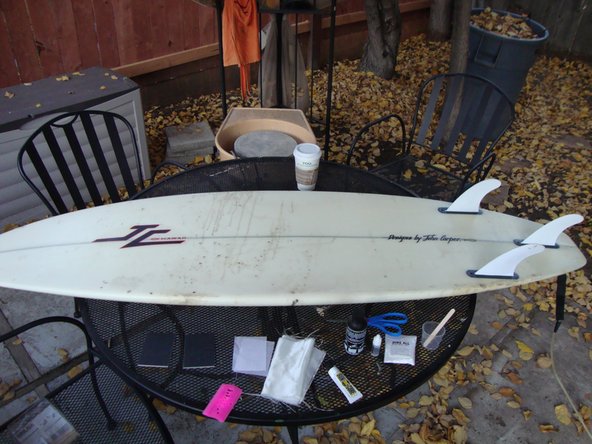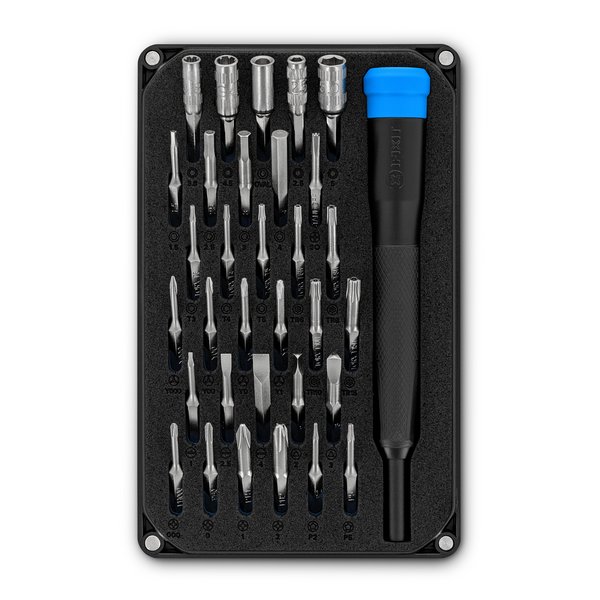
This is What It’s Like to Fix, an occasional series detailing the different kinds of work, and people, needed to fix the world.
Surfboards, despite their friendly shape and easy-going owners, have a surprising number of sworn enemies.
There are rocks, reefs, packed sand, and other ocean hazards. There are other surfboards, with pointy noses and sharp fins cutting deep gouges into one another. There are garage floors, car trunks, algae-covered concrete steps, and other slip-and-bump perils between garage and beach. Most menacing is ocean water itself, which can disintegrate a board’s innards if it gets inside.
Surfers can patch their own modest dings and breaks with resin, fiberglass cloth, sandpaper, and sunlight. iFixit’s Austin Blakely, a member of our EDU team, did just such a job during the pandemic. But really bad dings, or a lack of space or confidence, lead surfers to fixers like Gordon Andrew McKay, proprietor of Gordy’s Ding Repair in Grover Beach, Calif.

Gordy—Andy to his friends, but he likes Gordy as a trade name—is 52. He has surfed since he was 13, and picked up repair skills fixing boards for friends. He opened his shop when COVID-19 ended his job organizing surf events, created a surge of new surfers, and squeezed the supply of new boards.
The pandemic also shuttered two nearby surfboard shops’ repair operations. Gordy’s operation is a warehouse, two employees, a phone number, an Instagram page, and word of mouth. But business has been brisk.
Modern surfboards are essentially two things: a lightweight core of either polyurethane or epoxy, and a glass-like resin shell. The problem with a ding in your board (besides changes in fluid dynamics) is salty water getting inside. The board loses buoyancy, and with enough time, saltwater can broadly separate the foam from the resin—death by delamination.

That’s why Gordy likes to hear the story of what happened, and see pictures, before he takes in a board. When someone rips out their fin box (the slot for travel-friendly detachable fins) or suffers a nasty ding, he grabs one of three different routers to cut a perfect-sized hole. You have to carve out more than the hole itself—“Get all the cancer out, dry it out entirely,” Gordy said. Sometimes it’s easy to see the small, yellowed saltwater contamination. Sometimes, as with one stand-up epoxy paddle board Gordy rescued, it can take up to a month to fully dry out.
After filling in the excised foam and applying a fiberglass patch, it’s time for the resin. Most times, with a polyurethane board, Gordy can patch it, pour the resin, shape it, cure it in the sun, and sand it, all within a few hours. With newer epoxy boards, resin application is far more fickle. “Moisture, temperature, anything can throw it off,” Gordy said. “You’ll fix a ding, give it a full eight hours, you go to sand it, and it turns out there’s one spot that bubbled like crazy. Now you’ve gotta go back and fill that air bubble, sometimes fill it two or three times. And you might never know why, what was different this time.”
Those ambiguities are the toughest part of Gordy’s trade. A board comes in and looks like a half-day job, but the peculiarities of water, salt, foam, fiberglass, and resin can leave him working many hours past the estimate a customer pays. He’s getting better at forecasting, but the practice is tough. “You hit that point where you realize you underestimated, and it’s bad, but you gotta own it.”
Gordy is happy to take on a challenge, but he’s also turned down good money for lost causes—some boards just need to be put out to pasture. “Like a busted old car, there’s a point where you have to stop sinking money into it.” Small boards that have snapped, for example, or the deeply waterlogged. Still, it’s a fine line—surfboard production is down and demand is way up, so used boards get more care than they once did.
Austin at iFixit refused to give up on his board, even after he snapped the nose off on rocks; it came out dangling by its fiberglass shell. He put the board up on a patio set in the backyard, mixed some Q-cell (a.k.a. “Ding All”) with resin, and filled in the cut-out foam. Then he laid down some base resin, applied fiberglass, covered it all up with resin again, then waited a long time. Once it was dry, he sanded it all down, and, et voilà—it was ready for shredding.
His total kit for the procedure: a squeegee to press the fiberglass into the resin, a utility knife, a container for mixing the Q-cell into the resin, and some free wooden stir sticks. You can buy board repair kits with most of that for less than $30.
Was it a surgical nose job with no scars? Not quite. “Oh, you can tell,” Austin said. There are bumps “all over the place” on the top of the board. The area around the split line is raised slightly. From the bottom, you can more clearly see the break line.
Will that stop Austin from surfing it? No way. “Repair puts some character into your board,” he said. “Even a professional-level repair, as close as they can get to the original shape of the board? It’s a different board, in some ways. But it’s still yours.”











One Comment
Highly recommend Andy aka Gordy for repairs. He fixed a crack in the tail of my Firewire Timbertek quickly for only $20, and it looks great.
Cynthia Replogle - Reply